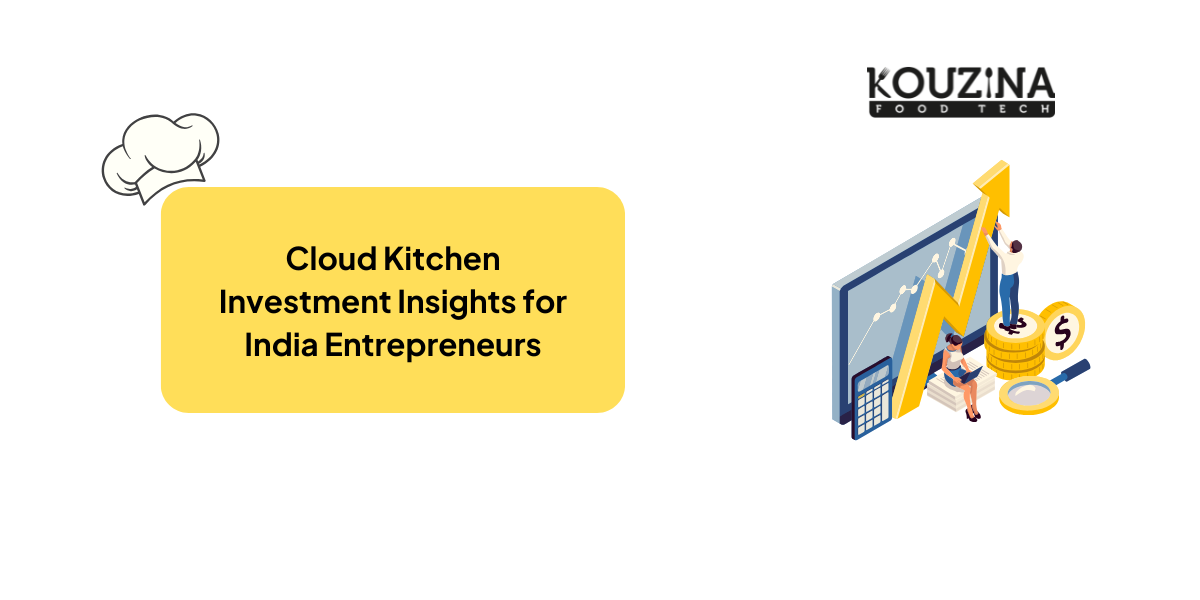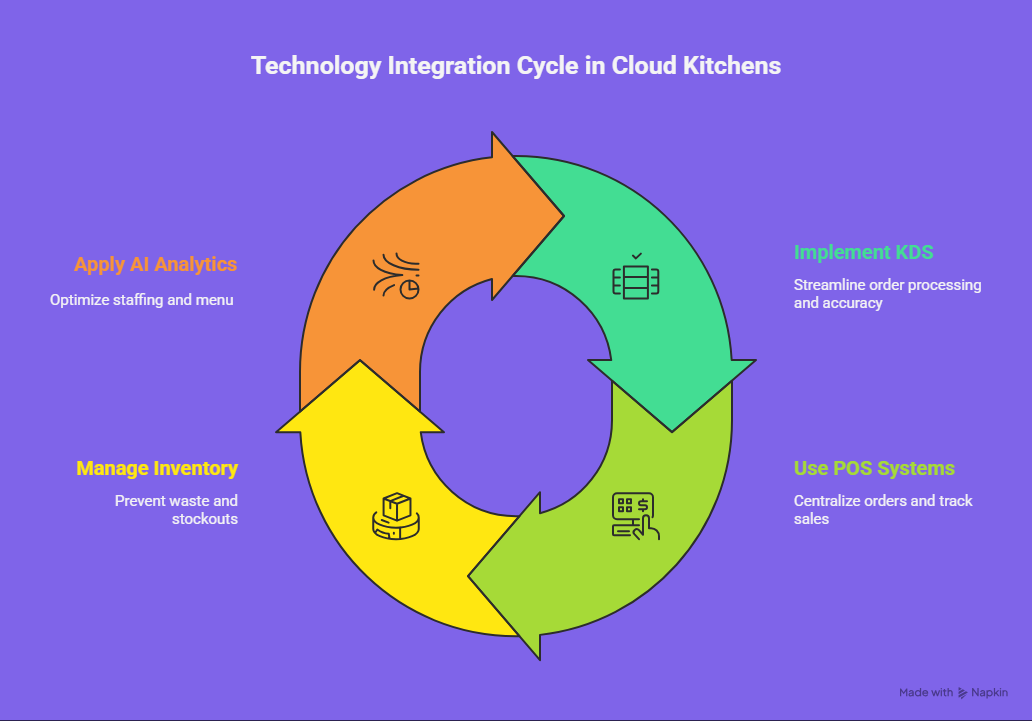
India’s food delivery boom has given rise to a powerful new business model, cloud kitchens, also known as ghost or virtual kitchens. These delivery-only operations bypass the high costs associated with dine-in spaces, offering a lean, tech-driven approach to launching food brands with lower risk, higher scalability, and faster returns compared to traditional restaurants.
In a market projected to reach ₹5,000 crore by 2026, cloud kitchens cater directly to the growing demand for quick, convenient, and quality food delivery.
In 2023, India's cloud kitchen market was valued at USD 969.5 million, and is expected to reach USD 1.13 billion by 2024, potentially surpassing USD 2 billion the same year. With a projected CAGR of 13.2% (2024–2032), the market is set to reach around USD 2.95 billion by 2032.
Understanding costs, profit margins, and operational models is essential for making informed, profitable decisions, regardless of one's level of expertise.
In this guide, we break down the key facts about cloud kitchen investors in India: how cloud kitchens work, the investment required, expected profits, and what to watch out for.
If you're considering entering the food business, this model offers a leaner, faster path to profitability.
A cloud kitchen, also known as a ghost kitchen or virtual kitchen, is a professional cooking facility that operates remotely. It prepares food solely for delivery, typically through online food aggregators. There is no storefront, no dine-in area, and often no direct customer interaction. Operations are lean, focusing purely on food production and efficient dispatch.

This model allows businesses to operate multiple brands from a single kitchen. You can offer various cuisines under different brand names. This flexibility enables rapid adaptation to market trends. It also allows for efficient use of shared resources.
India's burgeoning online food delivery market makes cloud kitchens a lucrative investment opportunity. Several key factors contribute to this growth. Understanding these drivers is essential for potential investors.
The demand for online food delivery has skyrocketed across India. Urbanization and busy lifestyles mean more people prefer convenient meal solutions.
Platforms like Swiggy and Zomato have made ordering food incredibly easy. This shift creates a massive market for delivery-only kitchens.
The Indian online food ordering and delivery market was valued at USD 31.77 billion in 2024. It is projected to reach USD 140.85 billion by 2030. This rapid expansion presents immense opportunities.
Starting a cloud kitchen requires significantly less capital than a traditional restaurant. You avoid expenses like prime real estate, elaborate interiors, and extensive front-of-house staff. This lower entry barrier makes it accessible for aspiring entrepreneurs.
Initial setup costs for a cloud kitchen can range from ₹1.5 lakhs to ₹12 lakhs. In contrast, a small dine-in restaurant might require ₹15-20 lakhs or more. This cost efficiency allows for faster break-even points.
The cloud kitchen model offers exceptional scalability. You can easily expand operations by adding new brands or locations. Without the constraints of a physical dining area, expansion is quicker and less costly.
The model also provides immense flexibility. You can experiment with various cuisines and menu items. Adapting to customer feedback and market trends becomes much simpler. This agility is a significant competitive advantage.
Cloud kitchens generally boast higher profit margins compared to traditional restaurants. While commissions to delivery platforms can be 15-30%, reduced overheads compensate for this.
Typical profit margins range from 15-25% for well-managed operations. Traditional restaurants typically have margins ranging from 5% to 15%.
Want to start a restaurant but don't want to cope with the expensive overhead? The only place to look is the Kouzina franchise!
Before investing, you must evaluate several critical aspects. These considerations will impact your setup, operations, and ultimately, your profitability. Thorough planning is paramount for success.
Though cloud kitchens lack a storefront, location remains vital. Select areas with high population density and strong demand for online food delivery.
Proximity to residential areas, corporate hubs, or student communities is beneficial. Consider locations with affordable rent but good access for delivery riders.
Strategic placement enables faster delivery times. It also helps you effectively cater to specific demographic groups. Researching hyperlocal demand is crucial for optimizing your location choice.
Your menu is the heart of your cloud kitchen. Focus on dishes that travel well and maintain quality during delivery. Offer diverse cuisines to cater to various tastes or specialize in a niche. High-demand items with good profit margins are ideal.
Developing strong virtual brands is equally important. Create unique brand identities for each cuisine or concept. Utilize compelling names, logos, and packaging to make a lasting impression. Effective branding builds customer recall and loyalty.

Technology forms the backbone of a successful cloud kitchen. Investing in robust order management systems is essential.
Efficient kitchen operations are essential for ensuring timely deliveries and maintaining consistent quality. Streamline your workflow from order receipt to dispatch. Implement Standard Operating Procedures (SOPs) for every task.
Recruit skilled kitchen staff who can handle high volumes efficiently. Cross-training staff can improve flexibility. Consider a lean team to control labor costs. Proper hygiene and food safety practices are non-negotiable.
Cloud kitchens rely heavily on online visibility. Partnering with major food delivery platforms is essential. Optimize your listings with attractive photos and clear descriptions.
Beyond aggregators, consider direct marketing. Utilize social media marketing to connect with your customers. Run targeted ads and promotions. Loyalty programs can encourage repeat orders. Positive online reviews are crucial for building a strong reputation.
Thinking of starting your cloud kitchen? Kouzina offers comprehensive, end-to-end solutions to help entrepreneurs establish and operate fully optimized cloud kitchens with multiple food brands. Start your journey today with an investment as low as INR 12-15 lakhs!
Understanding the financial dynamics is critical for any investor. Cloud kitchens offer attractive financial prospects if managed effectively.

Typical initial expenses include:
Regular operational costs include:
Revenue largely depends on order volume and average order value.
Most home-based cloud kitchens can break even within six to eight months. This indicates a relatively fast return on investment.
Also read: Starting a Cloud Kitchen in India: A Guide on Investment and Revenue
Navigating regulatory requirements is crucial for legal and sustainable operations. India has specific licenses and compliances for food businesses.
The Food Safety and Standards Authority of India (FSSAI) license is mandatory.
The FSSAI license ensures adherence to food safety and hygiene standards. Most food aggregators require this license for onboarding.
Ensuring all licenses are in place avoids penalties and operational disruptions. Regular renewal of licenses is equally important.
While promising, the cloud kitchen model presents its own set of challenges. Proactive strategies can help overcome these hurdles.
The low entry barrier means high competition. To stand out, focus on unique selling propositions (USPs). This could be a niche cuisine, exceptional quality, or innovative packaging. Strong branding and targeted marketing are crucial for visibility.
Reliance on food delivery platforms means paying commissions. It also limits direct customer interaction. Diversify your order channels by developing your website or app. Build direct customer relationships through loyalty programs and feedback loops.
Without a physical presence, building brand recognition becomes more challenging. Invest in digital marketing, social media engagement, and compelling visual branding to enhance your online presence.
Encourage customers to leave reviews and respond actively to their feedback. Provide exceptional food and service to foster loyalty.
Efficient logistics are vital for customer satisfaction. Partner with reliable delivery services. Implement robust order tracking systems. Ensure food quality is maintained during transit. Consider your delivery fleet for better long-term control.
Skilled kitchen staff are essential. Train them on efficient workflow, hygiene, and quality control. Create a positive work environment to minimize employee turnover. The demand for skilled staff in cloud kitchens is growing.
Must read: Cloud Kitchen: Business Opportunities and Models in India
To make the most out of your cloud kitchen investment, it’s important to implement the right strategies:

Additionally, having your website or app can help you build a direct relationship with customers and reduce dependency on third-party platforms.
With Kouzina’s multi-brand cloud kitchen model and franchise support, you can run multiple popular brands like Indiana Burgers, Kaati Zone, and Warm Oven—all from one location. Take the first step towards owning a successful food franchise today!
The cloud kitchen market in India is poised for significant growth. The global cloud kitchen market is expected to reach $115.48 billion by 2029, growing at a CAGR of 12.4%. Asia-Pacific is projected to be the fastest-growing region.
Key trends driving future growth include:
For investors, opportunities lie in establishing multi-brand kitchens that specialize in underserved cuisines or developing tech solutions for cloud kitchens. Investing in infrastructure that supports multiple cloud kitchen brands (commissary kitchens) is also a viable option.
The cloud kitchen industry in India is experiencing rapid growth. As a cloud kitchen investor in India, you have a unique opportunity to tap into this low-overhead, high-demand market. By understanding the initial costs, profit potential, challenges, and strategies for success, you can make a well-informed investment decision. The key to thriving in this industry is smart planning, strategic marketing, and operational excellence.
If you’re ready to take the next step, now is the perfect time to invest in a cloud kitchen and join the booming food delivery market in India.
If you're an entrepreneur looking to enter the booming cloud kitchen industry, Kouzina offers a unique opportunity to build a profitable business with low initial investment. Contact us today to learn more about our cloud kitchen setup and franchise support!
1. What is a cloud kitchen, and how does it work?
A cloud kitchen is a food delivery-only business that does not offer dine-in options. It utilises online platforms such as Zomato and Swiggy for placing orders and delivering them.
2. Do I need an FSSAI license to start a cloud kitchen in India?
Yes, an FSSAI license is mandatory for all food businesses, including cloud kitchens, to ensure food safety and compliance with legal requirements.
3. What are the startup costs for opening a cloud kitchen?
Startup costs range from INR 5 lakhs to INR 15 lakhs, depending on the kitchen setup, equipment, licensing, and marketing expenses.
4. How can I make my cloud kitchen profitable?
Focus on efficient operations, strong marketing, high-quality food, and partnering with multiple delivery platforms to reach a broader customer base.
5. How long does it take to get an FSSAI license for a cloud kitchen?
It typically takes between 10 days and several weeks, depending on the license type and the completeness of the application.